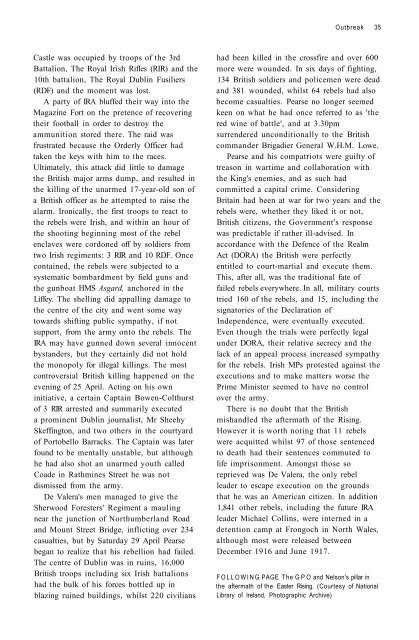You also want an ePaper? Increase the reach of your titles
YUMPU automatically turns print PDFs into web optimized ePapers that Google loves.
Outbreak 35<br />
Castle was occupied by troops of the 3rd<br />
Battalion, <strong>The</strong> Royal <strong>Irish</strong> Rifles (RIR) and the<br />
10th battalion, <strong>The</strong> Royal Dublin Fusiliers<br />
(RDF) and the moment was lost.<br />
A party of IRA bluffed their way into the<br />
Magazine Fort on the pretence of recovering<br />
their football in order to destroy the<br />
ammunition stored there. <strong>The</strong> raid was<br />
frustrated because the Orderly Officer had<br />
taken the keys with him to the races.<br />
Ultimately, this attack did little to damage<br />
the British major arms dump, and resulted in<br />
the killing of the unarmed 17-year-old son of<br />
a British officer as he attempted to raise the<br />
alarm. Ironically, the first troops to react to<br />
the rebels were <strong>Irish</strong>, and within an hour of<br />
the shooting beginning most of the rebel<br />
enclaves were cordoned off by soldiers from<br />
two <strong>Irish</strong> regiments: 3 RIR and 10 RDF. Once<br />
contained, the rebels were subjected to a<br />
systematic bombardment by field guns and<br />
the gunboat HMS Asgard, anchored in the<br />
Liffey. <strong>The</strong> shelling did appalling damage to<br />
the centre of the city and went some way<br />
towards shifting public sympathy, if not<br />
support, from the army onto the rebels. <strong>The</strong><br />
IRA may have gunned down several innocent<br />
bystanders, but they certainly did not hold<br />
the monopoly for illegal killings. <strong>The</strong> most<br />
controversial British killing happened on the<br />
evening of 25 April. Acting on his own<br />
initiative, a certain Captain Bowen-Colthurst<br />
of 3 RIR arrested and summarily executed<br />
a prominent Dublin journalist, Mr Sheehy<br />
Skeffington, and two others in the courtyard<br />
of Portobello Barracks. <strong>The</strong> Captain was later<br />
found to be mentally unstable, but although<br />
he had also shot an unarmed youth called<br />
Coade in Rathmines Street he was not<br />
dismissed from the army.<br />
De Valera's men managed to give the<br />
Sherwood Foresters' Regiment a mauling<br />
near the junction of Northumberland Road<br />
and Mount Street Bridge, inflicting over 234<br />
casualties, but by Saturday 29 April Pearse<br />
began to realize that his rebellion had failed.<br />
<strong>The</strong> centre of Dublin was in ruins, 16,000<br />
British troops including six <strong>Irish</strong> battalions<br />
had the bulk of his forces bottled up in<br />
blazing ruined buildings, whilst 220 civilians<br />
had been killed in the crossfire and over 600<br />
more were wounded. In six days of fighting,<br />
134 British soldiers and policemen were dead<br />
and 381 wounded, whilst 64 rebels had also<br />
become casualties. Pearse no longer seemed<br />
keen on what he had once referred to as 'the<br />
red wine of battle', and at 3.30pm<br />
surrendered unconditionally to the British<br />
commander Brigadier General W.H.M. Lowe.<br />
Pearse and his compatriots were guilty of<br />
treason in wartime and collaboration with<br />
the King's enemies, and as such had<br />
committed a capital crime. Considering<br />
Britain had been at war for two years and the<br />
rebels were, whether they liked it or not,<br />
British citizens, the Government's response<br />
was predictable if rather ill-advised. In<br />
accordance with the Defence of the Realm<br />
Act (DORA) the British were perfectly<br />
entitled to court-martial and execute them.<br />
This, after all, was the traditional fate of<br />
failed rebels everywhere. In all, military courts<br />
tried 160 of the rebels, and 15, including the<br />
signatories of the Declaration of<br />
Independence, were eventually executed.<br />
Even though the trials were perfectly legal<br />
under DORA, their relative secrecy and the<br />
lack of an appeal process increased sympathy<br />
for the rebels. <strong>Irish</strong> MPs protested against the<br />
executions and to make matters worse the<br />
Prime Minister seemed to have no control<br />
over the army.<br />
<strong>The</strong>re is no doubt that the British<br />
mishandled the aftermath of the Rising.<br />
However it is worth noting that 11 rebels<br />
were acquitted whilst 97 of those sentenced<br />
to death had their sentences commuted to<br />
life imprisonment. Amongst those so<br />
reprieved was De Valera, the only rebel<br />
leader to escape execution on the grounds<br />
that he was an American citizen. In addition<br />
1,841 other rebels, including the future IRA<br />
leader Michael Collins, were interned in a<br />
detention camp at Frongoch in North Wales,<br />
although most were released between<br />
December 1916 and June 1917.<br />
FOLLOWING PAGE <strong>The</strong> GPO and Nelson's pillar in<br />
the aftermath of the Easter Rising. (Courtesy of National<br />
Library of Ireland, Photographic Archive)



